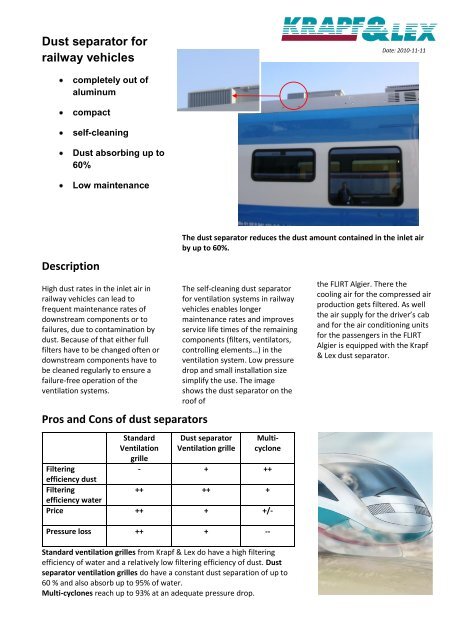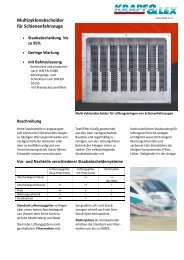Dust separator for railway vehicles - Krapf & Lex: Home
Dust separator for railway vehicles - Krapf & Lex: Home
Dust separator for railway vehicles - Krapf & Lex: Home
You also want an ePaper? Increase the reach of your titles
YUMPU automatically turns print PDFs into web optimized ePapers that Google loves.
<strong>Dust</strong> <strong>separator</strong> <strong>for</strong><br />
<strong>railway</strong> <strong>vehicles</strong><br />
completely out of<br />
aluminum<br />
compact<br />
Description<br />
self-cleaning<br />
<strong>Dust</strong> absorbing up to<br />
60%<br />
Low maintenance<br />
High dust rates in the inlet air in<br />
<strong>railway</strong> <strong>vehicles</strong> can lead to<br />
frequent maintenance rates of<br />
downstream components or to<br />
failures, due to contamination by<br />
dust. Because of that either full<br />
filters have to be changed often or<br />
downstream components have to<br />
be cleaned regularly to ensure a<br />
failure-free operation of the<br />
ventilation systems.<br />
Pros and Cons of dust <strong>separator</strong>s<br />
Filtering<br />
efficiency dust<br />
Filtering<br />
efficiency water<br />
Price<br />
Pressure loss<br />
Standard<br />
Ventilation<br />
grille<br />
The dust <strong>separator</strong> reduces the dust amount contained in the inlet air<br />
by up to 60%.<br />
The self-cleaning dust <strong>separator</strong><br />
<strong>for</strong> ventilation systems in <strong>railway</strong><br />
<strong>vehicles</strong> enables longer<br />
maintenance rates and improves<br />
service life times of the remaining<br />
components (filters, ventilators,<br />
controlling elements…) in the<br />
ventilation system. Low pressure<br />
drop and small installation size<br />
simplify the use. The image<br />
shows the dust <strong>separator</strong> on the<br />
roof of<br />
<strong>Dust</strong> <strong>separator</strong><br />
Ventilation grille<br />
Multicyclone<br />
- + ++<br />
++ ++ +<br />
++ + +/-<br />
++ + --<br />
Standard ventilation grilles from <strong>Krapf</strong> & <strong>Lex</strong> do have a high filtering<br />
efficiency of water and a relatively low filtering efficiency of dust. <strong>Dust</strong><br />
<strong>separator</strong> ventilation grilles do have a constant dust separation of up to<br />
60 % and also absorb up to 95% of water.<br />
Multi-cyclones reach up to 93% at an adequate pressure drop.<br />
Date: 2010-11-11<br />
the FLIRT Algier. There the<br />
cooling air <strong>for</strong> the compressed air<br />
production gets filtered. As well<br />
the air supply <strong>for</strong> the driver’s cab<br />
and <strong>for</strong> the air conditioning units<br />
<strong>for</strong> the passengers in the FLIRT<br />
Algier is equipped with the <strong>Krapf</strong><br />
& <strong>Lex</strong> dust <strong>separator</strong>.
Technical data<br />
Pressure loss<br />
pressure loss<br />
200 Pa<br />
150 Pa<br />
100 Pa<br />
50 Pa<br />
loss<br />
0 Pa<br />
0 500 1000 1500 2000 2500 3000<br />
<strong>Dust</strong> separation with all authorizations <strong>for</strong> <strong>railway</strong> <strong>vehicles</strong><br />
Our filters protect against …<br />
air flow in m³/h<br />
You receive <strong>Krapf</strong> & <strong>Lex</strong> dust<br />
<strong>separator</strong> with:<br />
Certificate of welding<br />
Certificate of fire<br />
prevention<br />
proof of vibration test<br />
In the past there were no<br />
systems <strong>for</strong> the pre-separation<br />
of dust adjusted to the branch.<br />
Usually multi-cyclones which<br />
have been originally developed<br />
Ventilation grilles dust <strong>separator</strong><br />
feature a filtering efficiency of up<br />
to 60% with dust particles bigger<br />
10 µm. These data were<br />
determined through<br />
measurements by the university of<br />
Amberg-Weiden.<br />
Important pre-condition there<strong>for</strong>e<br />
is the continuous exhaust of the<br />
separated dust by a dust discharge<br />
ventilator.<br />
The air volume of the dust<br />
discharge ventilator must amount<br />
approx. from 10 up to 20% of the<br />
total volume flow.<br />
The ventilation grille optimized <strong>for</strong><br />
dust separation shows minor<br />
pressure drops compared to<br />
cyclone <strong>separator</strong>s.<br />
At 1000 m³/h the air speed<br />
amounts approx. 2 m/s. The<br />
optimal dimensioning range lies<br />
between 3 m/s (approx. 1500<br />
m³/h) and 4 m/s (approx. 2200<br />
m³/h).<br />
At 4 m/s the pressure drop lies at<br />
approx. 120 Pa.<br />
<strong>for</strong> the military- and commercial<br />
vehicle sector were used. But<br />
these systems do not have the<br />
authorizations customary <strong>for</strong> the<br />
<strong>railway</strong> industry.<br />
Or standard ventilation grilles<br />
have been used, which cannot<br />
assure a continuous dust<br />
separation.<br />
Request our in<strong>for</strong>mation about <strong>Krapf</strong> & <strong>Lex</strong> multicyclones!<br />
… pressure shocks<br />
… dust<br />
… water<br />
… snow<br />
Pressather Str. 157<br />
D - 92637 Weiden i. d. OPf.<br />
Phone. + 49 (0)961 / 6 34 84 - 50<br />
Fax. + 49 (0)961 / 6 34 84 – 54<br />
e-mail contact@krapf-lex.de<br />
www.krapf-lex.de



